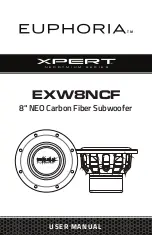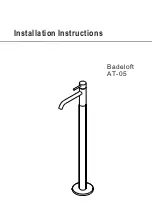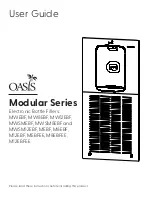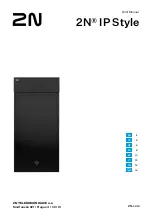
5
4
FRAME DIAMETER
MOUNTING DEPTH
CUTOUT DIAMETER
EXW8NCF
MODEL
8.76” / 222.56mm
5.41" / 137.5mm
7.17" / 182.31mm
Frame Diameter
Mounting Depth
Cutout Diameter
A
A
B
C
B
C
The purpose of the information below is to help you select the most appropriate type of enclosure for your
application. We have selected the two most popular enclosure types and their performance benefits.
Sealed Enclosure (Air-Suspension design): Characteristically simpler to make, sealed enclosures usually are
better at controlling the woofer’s excursion and performance at lower frequencies. The added control allows
for higher power handling or use of a bigger amplifier. The secret is to maintain a perfect seal. Using Glues
and sealants at all seams is recommended to prevent leaks and integrity of the enclosure. The size or volume
of the enclosure will directly affect the performance of the woofer. Smaller enclosures generally provide the
desired bump to the frequency response curb and Greater SPL. Larger enclosures will provide a lower but
flatter response for deeper bass. In general, the benefit to the sealed enclosure versus a ported enclosure
is a smaller foot print, simpler build with higher power handling, a more linear flat response, superior sound
quality and extended low frequency output.
Ported Enclosure (Bass-Reflex or Vented): A ported enclosure is simply a sealed enclosure with a port or
vent added to the sealed design for the purpose of tuning the enclosure to higher output at the desired
tuned frequency, typically 3db or higher. Another advantage of a ported enclosure is the reduction of cone
motion for the speaker, thus distortion at higher power levels within the tuned frequency response of the
port. A drawback is that building a ported enclosure is more complex than sealed. Having the wrong port or
vent could result in poor sound, and the potential of damaging a woofer when played too loud or out of the
tuning frequency. Thus we recommend not guessing, please follow the guidelines listed in this manual or go
to a professional. In General, the benefit of a ported enclosure versus a sealed is higher volume output at the
tuned frequency, stronger bass output with lower power input.
Construction: We recommend using ¾” MDF (Medium Density Fiberboard) for the construction of an
enclosure. It is critical for the side walls of the enclosure not to flex due to the pressure generated by the
woofer, bracing might be required. The enclosure sides should be secured together with nails/screwed. We
also recommend the use of glues and sealants to maintain the integrity of the enclosure and eliminate leaks.
B
A
It is difficult to give exact box dimensions that are universal for all cars and trucks. It is for this
reason that you must be able to calculate the space in which you have available in order to achieve
the proper air volume required.
It is recommended to build your enclosure from 3/ 4” thick MDF (medium density fiberboard).
Make sure the enclosure is sealed airtight.
Calculating External Volume
To calculate box volume, measure the outside Width x Height x Depth of
the enclosure.
Example 12” x 14” x 9”=1512 ÷ 1728” Cubic feet
Next you must convert cubic inches into cubic feet. To do this, you must
divide the cubic inches total by 1728”.
Example 1512 ÷ 1828=.875 Cubic feet
Calculating Internal Volume
To calculate the internal (net) volume of the above box you must first multiply
the thickness of the wood you are using by Two(2).
Example 3/4” x 2= 1.5“
Next subtract 1.5 from each of the outside measurements of the box.
Width
Height
Depth
12 - 1.5 = 10.5 14 - 1.5 = 12.5 9 - 1.5 = 7.5
C
Sealed
Vented
7.17 in.
(182.31mm)
5.41 in.
(137.49mm)
0.44 cuft.
(12.459 L)
0.86 cuft.
(24.352 L)
8.29 sq in
(53.48 cm2)
20 in.
(50.8 cm)
36Hz
2000 Watts
1000 Watts
ENCLOSURES
Woofer Cutout
Mounting Depth
Sealed Box
Vented Box
Vent Area
Vent Length
Tuning
Dynamic Power
Nominal Power
Multiple the new totals
(H x W x D)
Example: 10.5 x 12.5 x 7.5 = .5696
Next you must convert cubic
divide the cubic inch total by 1728”.
Example 984.375 ÷ 1728=.5696 cubic feet.
inches into cubic feet. To do this, you must
PRODUCT DIMENSIONS
RECOMMENDED ENCLOSURE
RECOMMENDED ENCLOSURE
CALCULATING ENCLOSURES























